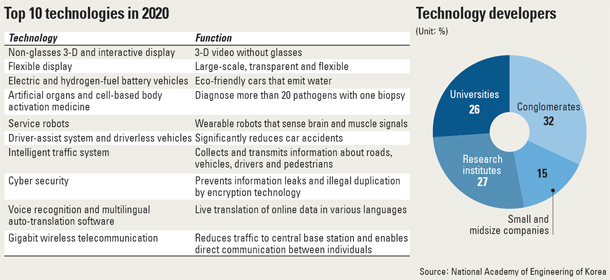Engineering a glimpse of the future

Through remote medical monitoring technology, people suffering from chronic illnesses who live far from hospitals will be able to receive live diagnoses by doctors through smartphones.
Patients in far-flung areas may live in houses that are quickly built and environmentally friendly thanks to modular methods that also consume less energy during construction.
It will also be easier for them to travel to regular checkups. The Intelligent Traffic System will alert drivers to congested routes and suggest alternatives.
Electric cars with hydrogen-fuel batteries will make significantly less noise, while driverless cars and the Advanced Driver Assistance System will give elderly people and the infirm more independence.
This is how Korean daily life will look in 2020, according to the academy and some 120 engineering experts.
All these scenarios are possible, they insist, with many of the key future technologies already introduced or under development by private companies and academic institutions.
Besides previously mentioned technologies, the report cites service and medical robots, flexible and transparent displays, and non-glasses 3-D and interactive displays.
Some of them are familiar to consumers through products like Samsung and LG Electronics’ curved display smartphones. BMW also expects to roll out its i3 electric vehicle in the first half of next year.
When undergoing further development, curved displays will eventually become even more flexible and transparent, according to the experts.
Amid the slowdown of the worldwide display market and heated competition due to newly emerging Chinese companies, key Korean display experts will work quickly to bring transparent, flexible and large displays to the market. Researchers and executives at LG Display, Samsung Display and Dongjin Semichem were identified in the NAEK report as leaders in the area.
Electric cars and those run with hydrogen fuel batteries will develop further than the current models from Hyundai, Kia and Renault Samsung. In particular, hydrogen batteries that leave only water after generating energy will contribute to the reduction of carbon emissions.
The academy encouraged officials from Hyundai Motor, the nation’s largest automaker, and the Korea Institute of Science and Technology to develop more technologies, to give wider access to these batteries at a more affordable price.
People will be able to watch 3-D videos without wearing the 3-D glasses with the technology that allows each eye to see two different videos. Researchers from the Korea Electronics Technology Institute, Seoul National University and Inha University will be in charge of development.
Intelligent robots that sense signals from the brain and muscles will make people’s lives more convenient and assist in medical procedures.
The medical robots will help people who suffer from a loss of physical functions. Existing robots that perform housework will become more sophisticated.
Officials from LG Electronics, TES and the Korea Institute of Industrial Technology were nominated as leaders in the field.
The highest number of technologies selected for the list came from conglomerates, at 32 percent, followed by research institutes at 27 percent and universities at 26 percent. Only 15 percent came from small and midsize companies.
“We tried to include as many small and midsize companies as possible, but realistically there are not many of them that specialize in high-technology aimed for future industry. I rather think we succeeded in becoming more inclusive than the initial expectation,” said Kim Jong-hoon, an official at the National Academy. “In addition, selections did not lean to a single industry. We worked with as many government ministries as possible.”
He explained that the future technology project is intended to provide guidelines for the Park Geun-hye administration’s policies related to future and industry.
Kim said the completed project was the first undertaken by the academy, but there are plans to continue offering concrete technology visions of the future every five years as new administrations take office.
He said the academy will start communicating with the government in 2014 to urge it to become involved and supportive, especially in offering financial resources to research and development groups.
“So far, those scientists and engineers who have achieved success dominate the public spotlight. This project was to encourage hidden leaders who possibly could develop Korea’s most representative technologies in the future,” Kim said.
BY KIM JI-YOON [jiyoon.kim@joongang.co.kr]










with the Korea JoongAng Daily
To write comments, please log in to one of the accounts.
Standards Board Policy (0/250자)